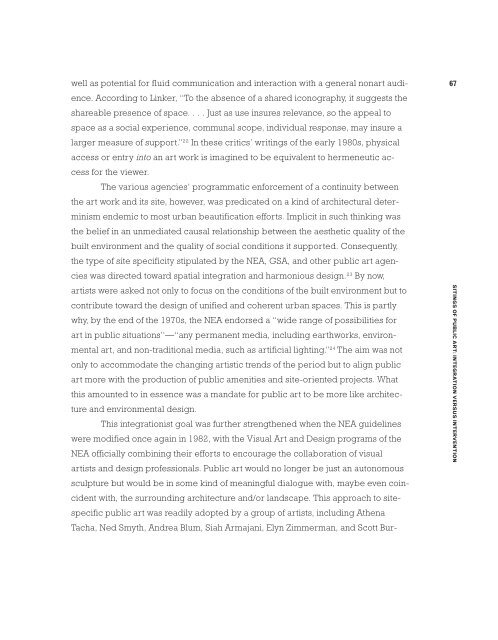ONE PLACE AFTER ANOTHER - Monoskop
ONE PLACE AFTER ANOTHER - Monoskop
ONE PLACE AFTER ANOTHER - Monoskop
Create successful ePaper yourself
Turn your PDF publications into a flip-book with our unique Google optimized e-Paper software.
well as potential for fluid communication and interaction with a general nonart audience.<br />
According to Linker, “To the absence of a shared iconography, it suggests the<br />
shareable presence of space. ... Just as use insures relevance, so the appeal to<br />
space as a social experience, communal scope, individual response, may insure a<br />
larger measure of support.” 22 In these critics’ writings of the early 1980s, physical<br />
access or entry into an art work is imagined to be equivalent to hermeneutic ac-<br />
cess for the viewer.<br />
The various agencies’ programmatic enforcement of a continuity between<br />
the art work and its site, however, was predicated on a kind of architectural determinism<br />
endemic to most urban beautification efforts. Implicit in such thinking was<br />
the belief in an unmediated causal relationship between the aesthetic quality of the<br />
built environment and the quality of social conditions it supported. Consequently,<br />
the type of site specificity stipulated by the NEA, GSA, and other public art agencies<br />
was directed toward spatial integration and harmonious design. 23 By now,<br />
artists were asked not only to focus on the conditions of the built environment but to<br />
contribute toward the design of unified and coherent urban spaces. This is partly<br />
why, by the end of the 1970s, the NEA endorsed a “wide range of possibilities for<br />
art in public situations”—“any permanent media, including earthworks, environmental<br />
art, and non-traditional media, such as artificial lighting.” 24 The aim was not<br />
only to accommodate the changing artistic trends of the period but to align public<br />
art more with the production of public amenities and site-oriented projects. What<br />
this amounted to in essence was a mandate for public art to be more like architecture<br />
and environmental design.<br />
This integrationist goal was further strengthened when the NEA guidelines<br />
were modified once again in 1982, with the Visual Art and Design programs of the<br />
NEA officially combining their efforts to encourage the collaboration of visual<br />
artists and design professionals. Public art would no longer be just an autonomous<br />
sculpture but would be in some kind of meaningful dialogue with, maybe even coincident<br />
with, the surrounding architecture and/or landscape. This approach to sitespecific<br />
public art was readily adopted by a group of artists, including Athena<br />
Tacha, Ned Smyth, Andrea Blum, Siah Armajani, Elyn Zimmerman, and Scott Bur-<br />
67<br />
SITINGS OF PUBLIC ART: INTEGRATION VERSUS INTERVENTION

















